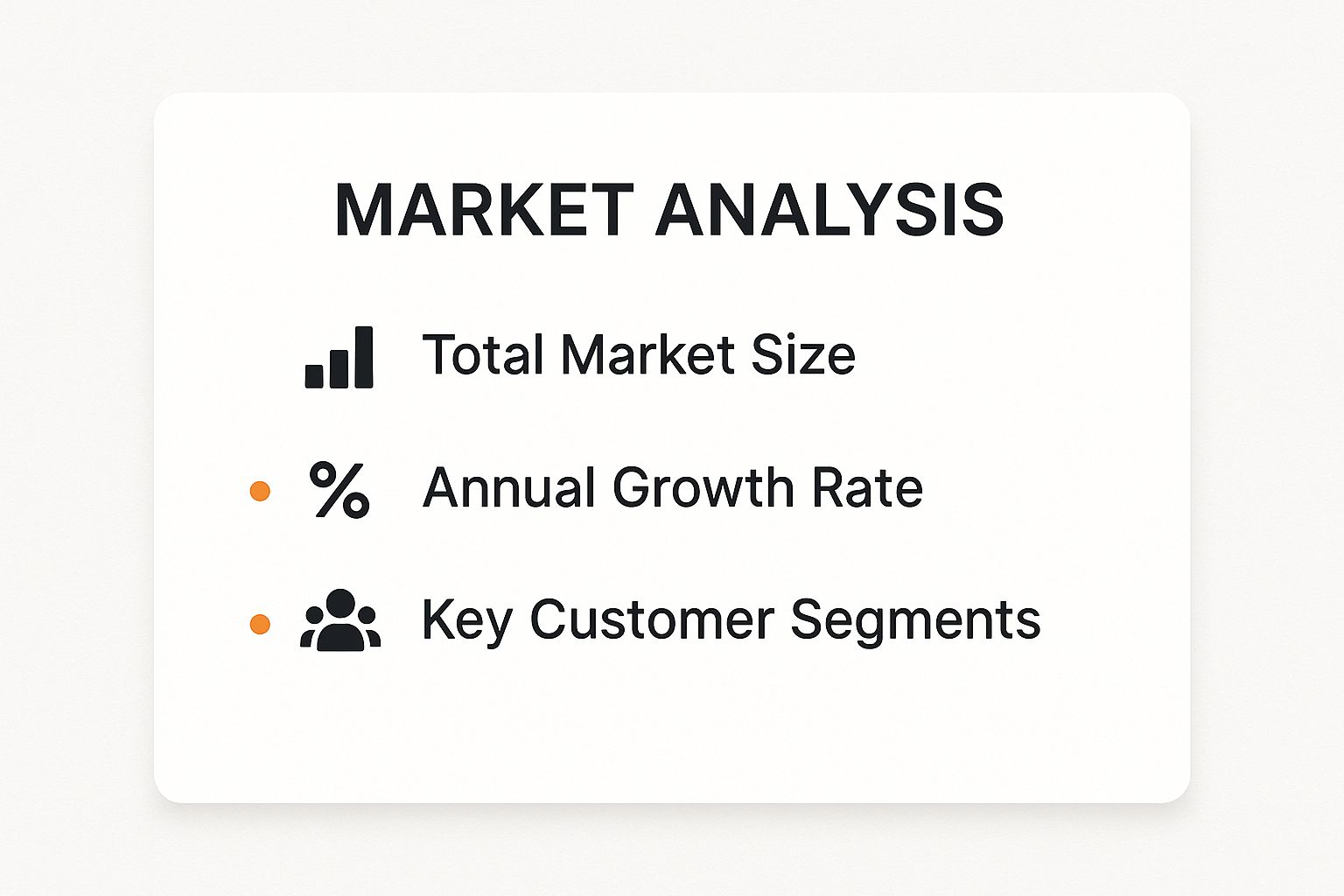A go-to-market strategy template is more than just a document; it's the operational blueprint guiding your product from the workshop to the customer's hands. It’s the master plan that gets your sales, marketing, and product teams rowing in the same direction, ensuring a cohesive and powerful launch.
Building Your Go To Market Strategy Blueprint
Before a single dollar is spent on ads or a single sales call is made, you need the architectural plan. I’ve seen too many launches fizzle out because they skipped this critical step. A solid GTM template acts as your command center, making sure every decision is intentional, backed by data, and directly tied to your bigger business objectives.
Think of it like this: launching a product without a GTM plan is like trying to build a house without a blueprint. Sure, you might get some walls up, but the foundation will be shaky, the rooms won't connect properly, and it almost certainly won't be what the buyer actually wanted. A well-constructed template forces you to confront the tough questions upfront, which saves a world of headaches and wasted cash later on.
The Essential Pillars of Your GTM Plan
Any GTM strategy worth its salt is built on a handful of core pillars. These aren't just siloed sections; they're interconnected components that build on each other to create a holistic plan, covering everything from the first glint of market analysis to the nitty-gritty of post-launch review.
This initial analysis phase is where you gather the raw materials for your entire strategy.

As the data shows, you have to start with a rock-solid understanding of the market size, its growth potential, and the specific customer segments you're targeting. These three data points are absolutely non-negotiable. They are the bedrock for building a product that solves a real-world problem.
To give you a clearer picture, let's break down the essential components that every comprehensive GTM strategy template needs. I've put together a quick reference table that outlines what each section does and the main question it should answer.
Core Components of a Go To Market Strategy Template
| Template Section | Primary Function | Key Question to Answer |
|---|---|---|
| Market & Customer Analysis | Defines your battleground and identifies your ideal buyer. | Who are we selling to, and what does their world look like? |
| Product Positioning & Messaging | Creates a unique space for your product in the market's mind. | Why should they choose us over everyone else? |
| Sales & Distribution Channels | Determines the most effective pathways to reach your customer. | Where do our customers shop, and how do we get there? |
| Goals & Success Metrics | Establishes tangible benchmarks for measuring performance. | What does a successful launch look like in numbers? |
| Launch Plan & Budget | Translates the strategy into a time-bound, resourced action plan. | What needs to happen, by when, and what will it cost? |
By building your go to market strategy template around these core pillars, you're not just creating a plan for one launch. You're developing a repeatable, scalable process that can be adapted for any new product or market you decide to tackle in the future.
Finding the Right Market and Customer

Let's be blunt: a brilliant product aimed at the wrong people is dead on arrival. The absolute cornerstone of your go to market strategy template is figuring out precisely who you're selling to and the world they live in. Get this part right, and everything else—from your messaging to your pricing—falls into place.
Too many founders stop at basic demographics like age, location, and job title. That's a start, but it's shallow. The real magic happens when you dig into psychographics and, more critically, the urgent pain points that actually compel someone to buy. You need to know what problem keeps them up at night.
For indie hackers and solopreneurs, finding these validated problems without a big research budget can feel impossible. But there's a secret: stop guessing and start listening. The answers are already out there in real-world conversations.
From Guesswork to Data-Driven Decisions
Instead of dreaming up what you think people want, find where they’re already complaining about their problems. Reddit, with its thousands of niche communities, is an absolute goldmine of raw, unfiltered user frustration and feature requests. The only problem? Manually digging through all that noise could take you weeks.
This is where you bring in a specialized tool. A perfect example is ProblemSifter, which was designed for this exact task. It systematically scans communities like r/SaaS and r/solopreneurs to pull out real, validated problems people are actively trying to solve. It turns chaotic forum threads into a clean, actionable list of ideas.
Unlike other tools, ProblemSifter doesn’t just suggest ideas—it connects you to the exact Reddit users asking for them. It hands you the original post and the usernames of people feeling the pain, creating a ready-made list for your first outreach calls.
This completely flips the script on traditional market research. You're not starting with an idea and hoping to validate it; you're starting with a proven problem and a built-in audience.
Uncovering Acute Pain Points
A powerful GTM strategy is always built on solving a "hair-on-fire" problem, not just a minor annoyance. As you fill out this part of your template, you need to zero in on the answers to these questions:
- What's the recurring problem? Identify the specific issue that keeps popping up in discussions.
- What have they already tried? Look for complaints about competitors or clunky workarounds. This is where you'll find your feature gaps and opportunities.
- What’s the real impact? Is this problem costing them time? Money? Sanity? Quantifying the pain is what makes your value proposition hit home.
- What language are they using? Pay close attention to their exact words. This isn't just research; it's your future marketing copy, handed to you on a silver platter.
If you want to go deeper on this foundational process, our guide on market research for startups offers a more detailed framework.
Tools like ProblemSifter make this discovery phase incredibly efficient. Instead of endless scrolling, you get a curated report of genuine pain points. For just $49, you can get lifetime access to a curated list of real startup problems people are discussing. With no subscriptions or hidden fees, it’s a tool built for founders who want to create solutions people are already begging for. This data-first approach ensures your GTM strategy is built on the solid ground of real user needs, not just a hunch.
Crafting Your Product Positioning and Message

Alright, you’ve zeroed in on your target customer. Now comes the real test: what are you going to say to them? This is where we get into the nitty-gritty of product positioning and messaging—the core of your go to market strategy template.
Think of it as building a bridge. On one side, you have your product. On the other, you have your customer’s biggest headache. Your messaging is that bridge. If you get it right, they see a clear path to solving their problem. If you get it wrong, they'll just keep scrolling.
Positioning is more than just a list of cool features. It’s about claiming a specific piece of real estate in your customer's mind. It has to answer their silent, skeptical question: "So what? Why should I care about your product?" Your message needs to connect the dots, showing exactly how your unique solution makes their life better.
Defining Your Unique Value Proposition
At the heart of all your messaging is your Unique Value Proposition, or UVP. This isn't just a catchy tagline; it’s a direct promise. It needs to be a sharp, clear statement that tells your ideal customer exactly what they're going to get.
To nail your UVP, I always come back to these three questions:
- What’s the pain? Get specific about the problem you're solving.
- What’s your secret sauce? How do you solve it in a way no one else can? This is your key differentiator.
- What’s the payoff? Show them the tangible result. Does it save them time? Make them more money?
For indie hackers, this means you have to get out of the "feature-speak" mindset. For instance, instead of saying your tool has "AI-powered analytics," say something like, "Our tool uses AI to slash your weekly reporting time in half." See the difference? One is a feature, the other is a benefit. This benefit-first language becomes the DNA for everything from your landing page to your emails.
If you're still wrestling with this, our guide on how to find product-market fit is a must-read, as strong positioning is impossible without it.
Ensuring Cross-Functional Alignment
Here’s where even the most brilliant messaging can fall apart: consistency. If your marketing, sales, and product teams aren't singing from the same hymn sheet, your customers will get a confusing, disjointed experience.
This isn’t just a nice-to-have; it's a critical success factor. Poor collaboration can kill growth. In fact, 50% of tech CMOs say that misalignment with their sales and customer success teams is one of the biggest roadblocks to hitting their goals. (You can dig into the research on these GTM strategy trends on roundtablemarketeers.com).
This is precisely why your go to market strategy template is so important. It has to be the single source of truth for your product's positioning. It ensures everyone, from the sales rep on a demo call to the marketer writing an ad, is telling the exact same compelling story.
Choosing Your Sales and Distribution Channels
Alright, you’ve nailed down your messaging. Now for the million-dollar question: how are you actually going to sell this thing? This part of your go-to-market plan is where you map out the specific pathways to get your product in front of the right people—and ultimately, into their hands. This isn't just about picking a channel; it's about architecting a system that works.
The channels you land on have to be the same places your audience already lives and breathes. If you're selling a B2B SaaS tool, you're probably going to lean heavily into content marketing and a direct sales team. If it’s a consumer app, maybe it’s a smart mix of TikTok ads and influencer collaborations. There's no magic bullet here, just what makes sense for your product and your market.
Aligning Channels with Customer Behavior
The whole point is to meet your customers where they are and make it incredibly easy for them to find you. Don't just jump on a bandwagon because everyone else is. Be deliberate.
For most B2B companies, the primary battlefield is digital. The data backs this up—recent stats show Google eats up 52% of B2B digital ad budgets, with LinkedIn close behind at 32%. This tells you where businesses are placing their bets, but simply showing up isn’t enough.
Real success comes from understanding the mindset of a user on each platform and shaping your approach to match.
- Direct Sales: This is your go-to for complex, high-value products. When a conversation is needed to explain the value and close the deal—think enterprise software or specialized services—you need a human touch.
- Content Marketing & SEO: This is the long game. It’s how you build trust and become the go-to resource for customers actively researching the problems you solve. Honestly, it's pretty much non-negotiable in today's world.
- Paid Advertising: Perfect for getting immediate feedback. You can quickly test messaging and target incredibly specific audiences on platforms like Google or LinkedIn to see what sticks.
- Partnerships: Why build an audience from scratch when you can borrow someone else's? This could be anything from a co-marketing webinar to a product integration or a reseller agreement with an established player.
The Overlooked Power of Brand Building
It's easy to get addicted to performance marketing channels like paid ads. They bring in leads, and the results are immediate. But they can become a crutch. An often-overlooked, yet incredibly powerful, distribution strategy is building a brand that pulls customers toward you organically.
Think about it: the single best distribution channel you can ever have is your own brand.
Here's a mind-blowing statistic to back that up: 77.3% of web traffic comes from brand-related sources. That means people are either typing your URL directly into their browser or Googling your company's name.
This single data point proves your go-to-market plan can't just be a collection of sales tactics. It has to be a blueprint for building a memorable brand through consistent messaging, genuinely helpful content, and an unforgettable customer experience. That’s how you turn a first-time buyer into a lifelong fan, creating a growth engine that sustains itself.
Without a strong brand, you’re forever stuck on the hamster wheel of paying to acquire every single customer.
Setting Goals and Measuring GTM Success

A strategy without a scorecard is really just wishful thinking. So, the final, absolutely critical piece of your go to market strategy template is defining what success actually looks like in hard numbers. This is where you have to move past vanity metrics—like social media likes or website traffic—and drill down into the key performance indicators (KPIs) that really move the needle for your business.
If you don't have clear goals, your launch efforts will be scattered and unfocused. You need to set tangible benchmarks that tell you, without a doubt, if your strategy is hitting the mark, where it’s coming up short, and when it’s time to pivot. It's this data-first mindset that separates a successful launch from one that just makes a lot of noise and then fades away.
Choosing KPIs That Truly Matter
I've seen it time and again, especially with founders flying solo or small indie teams: the temptation is to track every single metric you can get your hands on. That's a recipe for analysis paralysis.
Instead, zero in on a handful of KPIs that give you a crystal-clear picture of your business's health. Your GTM template should have a dedicated section, almost like a mini-dashboard, for these core metrics.
Here are the essentials I always recommend starting with:
- Customer Acquisition Cost (CAC): What's the real cost, in both marketing spend and sales effort, to land one new customer? You need to know this number cold.
- Customer Lifetime Value (LTV): Over the long haul, how much revenue can you realistically expect from a single customer? A sustainable business model always has an LTV that's significantly higher than its CAC.
- Conversion Rate: What percentage of people actually move from one stage of your funnel to the next? Think website visitors to trial sign-ups, or trial users to paying customers.
- Sales Cycle Length: How many days does it take to turn a fresh lead into a paying customer? The faster you can make this happen, the quicker you can scale your revenue.
The AI Factor in GTM Performance
It's impossible to talk about modern GTM strategies without mentioning AI's growing influence. The technology is delivering some seriously measurable improvements across the funnel, and the data gives a clear edge to companies that weave AI into their operations from the start.
For instance, big AI-native companies are seeing free trial conversion rates hover around 56%. That’s a massive jump compared to the 32% their non-AI counterparts are seeing. But it’s not all smooth sailing; sales quota attainment has remained stubbornly flat. You can dig into more of these insights in the current state of go-to-market performance report from ICONIQ Growth. This tells us that while AI can definitely give you a boost, it’s not a magic bullet. You still need a solid, holistic strategy.
Your GTM template isn't a "set it and forget it" document. It's a living, breathing tool. Use your KPI dashboard to run regular reviews—weekly for a new launch, maybe monthly once you're more established—and make adjustments based on what the data is telling you.
This constant feedback loop is what lets you refine your tactics, optimize where you're putting your money, and ultimately prove the ROI of your entire go-to-market effort. By setting clear goals and religiously tracking your progress, you turn a simple plan into a powerful, repeatable engine for growth.
Building Your Launch Plan and Budget
If strategy is the "what" and "why" of your go-to-market plan, then the launch plan is the "who," "when," and "how." This is the point where your go-to-market strategy template stops being a document and becomes a living, breathing timeline. You're mapping out every single task, giving it an owner, and setting firm deadlines to make sure the debut is coordinated and hits hard.
Without this operational roadmap, even a brilliant strategy can fall apart. I've seen it happen—teams get confused, deadlines slip, and the launch loses all its power. A surprising number of companies skip formalizing this step, which almost always leads to a weak market entry because they haven't allocated enough resources.
Structuring a Phased Rollout
A powerful launch isn't just one big bang. It's a carefully orchestrated campaign that unfolds in phases to manage complexity and build momentum. Your template should reflect this with dedicated sections for each stage.
Pre-Launch (4-6 weeks out): This is all about generating buzz and getting your audience ready. Think of it as the warm-up act. Your team will be finalizing website copy, prepping social media announcements, and maybe even leaking some info to key influencers or a private beta group.
Launch Day (The Main Event): All hands on deck. This is about making the biggest splash possible. The key activities are hitting "publish" on the big announcement, sending out that massive email blast, and flipping the switch on any paid ad campaigns. Everyone needs to be ready for the first wave of feedback and, inevitably, a few bug reports.
Post-Launch (The First 30 Days): The work is far from over once the product is out there. This critical period is for listening intently to user feedback, gathering testimonials for case studies, and digging into the initial performance data to see what’s working and what needs to be tweaked.
A detailed, phased plan is your best insurance against letting critical steps fall through the cracks. For a really granular view, our complete product launch checklist will help you cover every single base.
Allocating a Realistic Budget
Budgeting for a launch can feel like a guessing game, but getting it right is absolutely essential. Unfortunately, this is where many companies stumble. The data is pretty stark: a recent study found that 59% of companies feel they underinvest in their product launches.
What's more, a staggering 55% of organizations set aside between just $0 and $20,000 for their entire launch. You can dig deeper into these go-to-market planning statistics from Devrix.
Don't cripple your product's potential with a shoestring budget. A well-defined financial plan is what ensures your strategic priorities actually get the resources they need to make an impact.
Your template needs a straightforward budget allocation checklist. Start by listing out your key launch activities—things like content creation, paid media, PR, and maybe some influencer collaborations. Then, assign a percentage of the total budget to each one. This gives you a clear, defensible plan for how every dollar will be spent to get the best possible return.
A Few Lingering Questions on Go-to-Market Strategy
Let’s wrap things up by tackling a few of the most common questions I hear when teams are wrestling with their go-to-market plans.
How Often Should I Revisit My GTM Strategy?
Think of your GTM strategy as a living, breathing document—not something you write once and file away. You absolutely have to keep it current.
I recommend a quick review every quarter to make sure you're still on track. But plan for a much deeper, more comprehensive overhaul at least once a year. That said, don't wait for the calendar. If a disruptive new competitor lands on the scene, you release a game-changing feature, or the market itself suddenly shifts, it's time to open that document back up immediately. Staying agile is what separates a relevant launch plan from a historical artifact.
What’s the Single Biggest Mistake You See with GTMs?
Easy. Building the entire strategy on a foundation of pure assumptions. I’ve seen it happen more times than I can count: a team falls in love with their own solution without ever truly validating that the problem they think they're solving is a real, burning pain point for their target customers.
This is, without a doubt, the most fatal and yet most avoidable error. You have to de-risk your entire plan by confirming the problem first.
This is precisely why tools like ProblemSifter exist. They help you tap into real, unfiltered user complaints and pain points from places like Reddit before you sink a single dollar into development. By identifying not just the idea but the original Reddit users expressing the pain, it helps founders both ideate and promote their solution with targeted outreach.
Is It Okay to Have More Than One GTM Strategy?
Not only is it okay, but it's often essential for growth. It’s highly unlikely that a single, one-size-fits-all approach will work across the board.
For instance, you’ll almost certainly need distinct GTM strategies for different parts of your business:
- A plan for your flagship enterprise software will look nothing like the one for your new self-serve SMB product.
- The way you approach customers in North America might be completely ineffective in Europe or Asia.
- Even different customer segments, like selling to established corporations versus scrappy indie hackers, demand their own unique playbooks.
The trick is to make sure each strategy is meticulously tailored to its specific audience and market. That’s how you get real traction.
